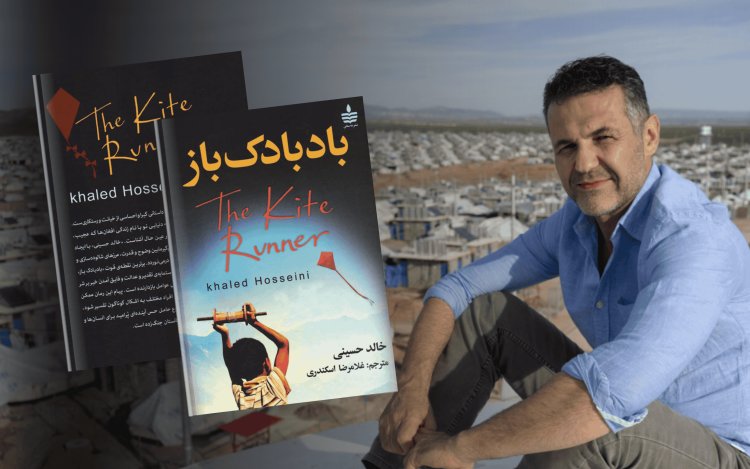Why Has The Kite Runner Been Banned in U.S. Schools?

Khaled Hosseini, the acclaimed Afghan American author, has confirmed that his novel The Kite Runner has been removed from the curricula of more than a hundred school districts in the United States. The ban began in 2020 and has recently spread rapidly across multiple states.
Last year, in a letter to the Brevard County School Board in Florida, Hosseini called the ban a “betrayal of students,” stressing:
“Banning books like The Kite Runner does not protect students in any way—it is, in fact, a betrayal of them. Depriving students of the chance to experience empathy, to understand others, and to expand their human perspective causes irreparable harm.”
Ban: Facing Reality or Avoiding It?
In recent years, The Kite Runner has been banned in schools in several U.S. states, including Texas, Florida, and Georgia. The stated reasons for the ban include “inappropriate sexual content,” “graphic violence,” and “references to religion and terrorism.” Groups of parents and conservative activists have labelled the book “disturbing” and “immoral” for teenagers, citing its exploration of religion, politics, and violence hence making it unsuitable for young readers.
Over the more than two decades since its publication, the book has been taught in many American schools as a powerful work for sparking conversations on friendship, betrayal, social class, guilt, redemption, and the complexities of Afghanistan and migration.
Hosseini has repeatedly said in interviews that, over the past 20 years, he has received countless letters from readers and students describing the profound impact the novel has had on their lives. For many, the book has been a window into the world of migrants, refugees, victims of violence, and the people of Afghanistan—changing their views on justice, empathy, humanitarian work, and human relationships.
The Kite Runner: A Window Into Afghanistan
In the early 2000s, the world entered a new political era following the September 11 terrorist attacks. In 2001, the United States invaded Afghanistan under the banner of the “War on Terror,” leading to the fall of the Taliban regime and the start of a prolonged U.S. military presence in the country.
It was during this time that Khaled Hosseini, an Afghan-born author living in America, published his debut novel in 2003. The book quickly became a bestseller in the United States, was translated into nearly 50 languages, and sold millions of copies worldwide. Its 2007 film adaptation, directed by Marc Forster, brought the story to an even wider audience.
At a moment when global attention was fixed on Afghanistan, this literary work offered a human, poetic, yet unflinching portrait of a country that, until then, had been largely known through the lens of war and conflict.
A Story From an Afghanistan the World Forgot
The Kite Runner tells the story of Amir, the son of a wealthy Pashtun family in 1970s Kabul, and Hassan, the loyal son of the family’s Hazara servant. Narrated by Amir, the book portrays a complex, unequal, and painful relationship between the two boys, shaped by Afghanistan’s rigid class hierarchy, ethnic discrimination, and deep-rooted religious and cultural beliefs.
The story begins during King Zahir Shah’s reign and follows Afghanistan’s political upheavals—from Daoud Khan’s coup and the Soviet invasion to the civil war, the first Taliban regime, and eventually, migration to the United States. In later chapters, the reader is confronted with the dark, oppressive atmosphere of Taliban rule in the late 1990s, where religious morality has been weaponized into violence and silence becomes a means of survival.
One of the novel’s most pivotal and controversial scenes is Hassan’s rape, which Amir witnesses but fails to stop—paralyzed by fear and helplessness. This moment becomes the turning point of the narrative, marking the beginning of Amir’s lifelong struggle with guilt and his eventual attempt at redemption through returning to Afghanistan.
A Story Beyond Afghanistan
The Kite Runner is not merely a story about Afghanistan; it is a meditation on guilt, shame, redemption, and confronting the past. It asks whether a person can live with their mistakes and whether there is a path to free oneself from the weight of one’s history.
Themes such as ethnic discrimination between Pashtuns and Hazaras, class division, migration, and identity crises among Afghan immigrants are deeply woven into the plot. For Amir, migration does not erase his past—it becomes a burden he carries with him. His return to Taliban-controlled Afghanistan is not only an attempt to save Hassan’s child but also a journey toward facing himself and seeking release.
Hosseini’s prose is simple, fluid, and emotionally charged. Blending elements of Western storytelling with Eastern narrative tradition, he creates a world that engages both teenage and adult readers. Vivid emotional landscapes and precise dialogue which make the novel one of the most impactful works on migration in contemporary literature.
Conclusion
According to PEN America, in recent years thousands of books have been banned in schools across the United States for addressing topics such as violence, sexuality, gender identity, and other controversial subjects. This wave of censorship reflects a fear that keeps society from engaging with complex realities.
The banning of The Kite Runner in U.S. schools is not just the removal of a literary work—it is the erasure of a human voice from a country long engulfed in crisis and profound political and social upheaval.
In today’s Afghanistan, where people face discrimination, insecurity, and multiple crises, stories like The Kite Runner become even more vital. They open windows to the human and cultural realities of Afghanistan, offering the world a chance to see beyond headlines and politics—and to witness the human beings behind the conflict.
